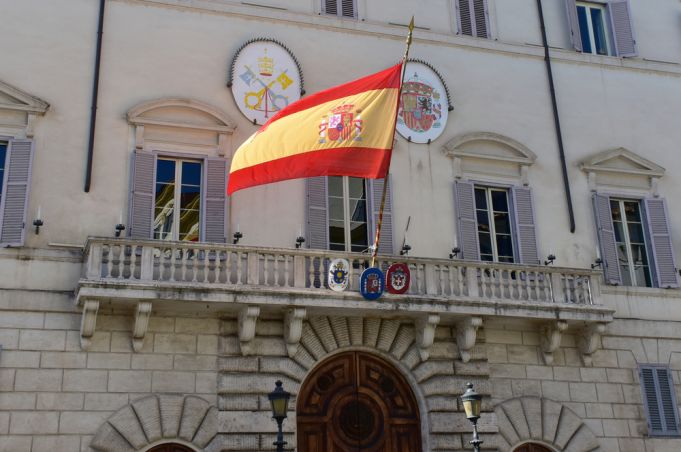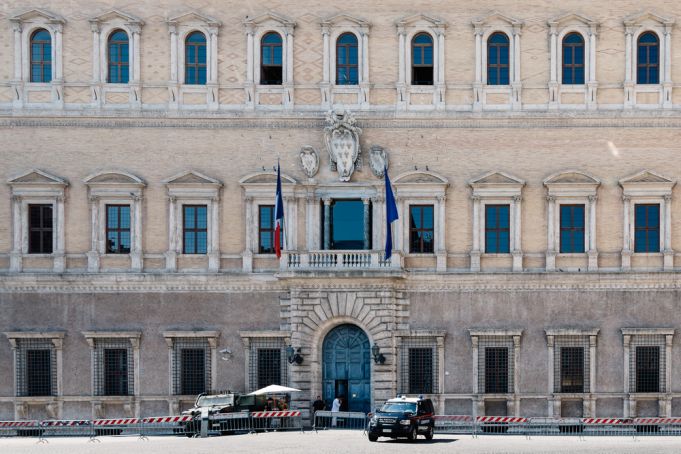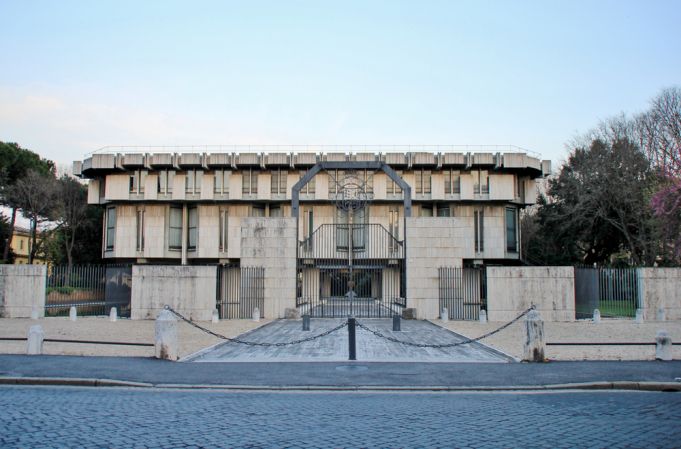How Rome Shaped Modern Diplomacy
A look at three landmark embassy buildings in Rome.
When an out-of-pocket diplomat named Niccolò Machiavelli came to Rome in 1503, the city was a hotspot of intrigue, information gathering and spying.Here, he would have picked up some of the important lessons that would go on to fill the pages of his notorious but often misunderstood book, The Prince, which he published a decade later. It's a book about greasing palms, exploiting weaknesses, and generally on how to get ahead in modern day diplomacy with the right doses of cunning, fortune and virtue.
Diplomacy, as Machiavelli attests to, has a long history in Italy. This is particularly the case in Rome where it has helped shape the city we know today.
In the late Middle Ages and early Renaissance period, Italy was dissected into a number of separate states. Wars were common. So in order to maintain a balance of power, rulers saw the need for crafty diplomatic interactions. They sent out envoys, who were usually the younger sons of aristocratic families - as well as their cook to stop them being poisoned.Rome, which was ruled over by the popes and the centre of Catholic Europe, became a cauldron for diplomacy. The popes, for example, were the first to create a diplomatic corps where they would address the envoys jointly. Soon after, countries such as Spain and France began to send permanent representatives to the city, giving rise to modern diplomacy with its unique customs and traditions.
One needs only to wander through the streets of Rome today and stumble over some of the grand embassies with their soaring baroque façades to appreciate how diplomacy shaped the modern city. Here are three to watch out for:
Embassy of Spain to the Holy See (Piazza di Spagna)
Having just celebrated its 400-year anniversary, the Spanish embassy to the Holy See is said to be the oldest embassy in the world.When the Spanish monarchy first rented the Monaldeschi palace in 1622, located at the southern-end in what is now Piazza di Spagna, the area was nothing more than a resting place for horse-drawn carriages arriving in the city from the northern Porta del Popolo. Weary visitors, eagerly anticipating their first glimpse of the Eternal City, would have been greeted by a few vines and some old grassy Roman ruins.
Spain, a Catholic super-power, had been sending envoys to Rome since at least the 1400s but by the early 17th century its diplomatic retinue had swelled to around 200 people. Spanish diplomats therefore needed an official permanent residence and the Monaldeschi palace seemed to fit the bill.

They eventually purchased the palace for 22,000 Roman escudos, a sum that could support four people for a month. The Count of Oñate commissioned architect Francesco Borromini to completely remodel the building, creating an entrance gallery, the vault of the main hall, the courtyard and an imposing square staircase.
Once the renovations were complete, the palace became a royal court, where ambassadors could host royal guests, dignitaries and artists. Velázquez painted The Forge of Vulcan in what was once the embassy’s bakery and is now the laundry. It is this court that many of the elaborate diplomatic customs and habits of modern diplomacy were first initiated.
With the French owning the territory around the Pincio, up the hill, Piazza di Spagna also became the site of lavish celebrations and parades paid for by the two states who saw these parties as a way of spreading the prestige of their respective kingdoms, and useful vehicles of propaganda and soft power.
Today the embassy is open for visit upon request via email. (Spain’s embassy to Italy is at Largo Fontanella di Borghese).
French embassy to Italy (Piazza Farnese)
Rising rent in Rome is a fact that is almost certainly lost on the bookkeepers buried within the bowels of the French treasury in Paris, who each month transfer just one euro of rent to the Italian state for Palazzo Farnese.A stone’s throw from Campo de' Fiori, the magisterial French embassy in Piazza Farnese is arguably one of the grandest buildings in the capital. With its marble fireplaces and columns, wall-to-wall frescoes, cavernous courtyard and priceless works by Michelangelo, Sangallo the Younger and Raffaello, the French pulled off the bargain of the century when they negotiated the terms of the rental from Mussolini in 1936.
Palazzo Farnese was originally built in 1517 and later expanded when Alessandro Farnese, a cardinal, became Pope Paul III in 1534. Construction was undertaken by architect Antonio da Sangallo but once he died, Michelangelo completed the palazzo, designing the second floor and the courtyard.

After the unification of Italy, Palazzo Farnese became the home of the French embassy in Italy. However, when the Italian government tried to increase the rent in 1909, France decided it would be simpler to just buy the building outright. This infuriated the locals, who feared losing one of their most prized buildings.
A newspaper at the time tried to reassure them, writing “France asked to buy the Farnese Palace, but not to take it home!” The deal was completed but Mussolini eventually bought the building back in 1936. He subsequently agreed to lease it to the French with the symbolic monthly payment for 99 years.
Today, the quiet area to the west and north of Piazza Farnese hosts some of the city’s most see-and-be-seen bars and restaurants. Palazzo Farnese is open to guided tours in English, Italian and French. Tickets should be bought well in advance here.
Embassy of the United Kingdom to Italy (Via XX Settembre)
Architecturally speaking, the British embassy, located next to the venerable Porta Pia, couldn't be further from the Renaissance splendour and chicness of Palazzo Farnese. Tucked in next to the Aurelian Walls in the north of the city, this concrete fortress has more in common with the aesthetic of the designer of the Führerbunker than that of Michelangelo.But there is a rugged handsomeness to the building's brutalist architecture. Unashamedly modern, the edifice is set back and fronted by two shallow pools with fountains. A causeway, offering a grand approach, leads to a courtyard. Then, a grand double staircase curves around the prow of what looks like a battleship to a piano nobile and the ambassador's offices.
Designed by British architect Sir Basil Spence, it replaced the original embassy that was blown up by political terrorists in 1946, who opposed British policy towards Jewish migration in Palestine.
Spence had gained fame in the UK by rebuilding Coventry Cathedral, which had been almost completely destroyed in the war. His style represented the defiance and optimism towards the future that characterised the post-war era in Britain.

In Rome, Spence wanted to design the embassy in harmony with the historic Porta Pia, built to Michelangelo's designs for Pius IV. The exterior of the embassy is made of blocks of travertine which were apparently suggested by the sturdy gate and its battlements.
However, when the embassy opened in 1971, critics largely felt Spence had not reached his full artistic potential as he had done in Coventry. The embassy staff at the time criticised the diamond‐ and triangle‐shaped offices for being too small and unattractive. Spence had faced similar criticisms for his designs before. In Glasgow, he designed tenement blocks based on the utopian principles of Le Corbusier, which were disliked by residents for being damp, cramped and generally pretty nasty. They were demolished in 1993 to cheers of delight.
Still ensconced in Spence’s hulking grey blocks, it is unclear whether the British diplomatic staff harbour similar complaints today. Only time will tell whether this modernist concrete bunker will celebrate its own 400-year anniversary or, who knows, maybe one day it will be yanked down to a Machiavellian cheer from its staff.
The embassy is not open to visitors but the ambassador’s residence, Villa Wolkonsky, recently opened its doors to visits for the FAI Giornate di Primavera initiative.
By Charles Seymour
This article was published in the May 2023 online edition of Wanted in Rome magazine. Cover image: France's embassy to Italy in Piazza Farnese. Photo credit: JJFarq / Shutterstock.com.


















